Category: Digital Transformation
Microsoft adds yet another powerful feature to the low-code/no-code PowerApps. An AI-powered Express Design that can convert any uploaded PDF, PPT, Figma files, hand-written sketches, or screenshots into a working app. Industry-leading AI is built into Express Design that allows seamlessly scanning inputs to produce working apps that can connect to various data sources.
How Express Design works?
1. Upload any files like PDF, take a pic of a hand-written note, a UI screenshot from another app, etc.
2. Power Apps’ inbuilt AI engine trained to recognize common application elements will automatically detect the upload and start generating a working app along with data schema in MS Dataverse
3. Edit this AI-generated app to suit your needs and add more elements
4. Next, integrate with databases like SAP, HubSpot, Salesforce, SQL, etc.
5. Customize the app further with your desired colors, user interface, etc.
Industry-wide use cases
1. Legacy data in various electronic formats which are lying in outdated libraries across many organizations
2. Conference room brain-storm sessions to startup ideas
3. Business function-specific requirements that need to be automated
4. Integration with Figma which enables using the same design with PowerApps Figma UI Kit
5. Interactive educational apps that can be used across a university
Benefits of Express Design in PowerApps
Being true low-code tool PowerApps’ addition of Express Design takes the low-code methodology a step further by enhancing the ease of creating business apps.
This flexibility and ease of creation give organizations the ability to democratize app creation for a specific need by a specific function/department without having to entirely depend on IT.
It also drives organizations to create individual and organizational governance policies along with encouraging innovation by design where ideas are converted, preserved, and shared across the organization fueling growth.
How we can help!
Inovar-Tech works with clients across industries like Manufacturing, Insurance, Healthcare, Telecom, Retail, Education, and State Governments.
We develop solutions for businesses to address their problems with Data Migration, Process optimization, Automation, Analytics, PowerApps, SharePoint portals, etc.
Talk to us to know more about our use cases and the solutions we provide!
In this era of Digital transformation, industries have enhanced their attempt to optimize business processes excelling through Microsoft Power Automate. Many companies are on a spree to trigger platforms like Microsoft Power Automate, Power BI, Power Apps, Power Virtual Bot, SharePoint, Microsoft Teams, and many more. Among which Power Automate is a tech-stack promising platform that boosts productivity and improves business process efficiency by saving time and cost.
The main backbone of any organization is the business processing unit. With the help of business process automation (BPA), companies achieve at the time spent in manual processing, any human errors made, and inefficiency of systems. Statistical analysis proves that with the help of BPA the markets are ballooning at a rapid increase of 10% every year.
What is Microsoft Power Automate?
Microsoft Power Automate formerly known as Microsoft Power Flow is a cloud-based service also known as a low-code or no-code automation tool, built specifically for workflow and process automation. It includes powerful Robotic Process Automation (RPA), called UI Flows, that allows quick and easy automation instead of time-consuming manual processes.
Companies leverage their platform by seamlessly using the Microsoft office 365 services
- To increase their productivity
- Reduce operational costs, and
- Enhance business process efficiency
Ways organizations can use Power Automate
- Create your own workflow
- Automation recurring, frequent, and routine tasks
- Automate legacy of business processes
- Automate cloud applications and databases
- Design logics for Power Apps
- Automate the central business workflow
Benefits of Power Automate in improving Business Process Efficiency
BPA can significantly alleviate many pain points that organizations are facing today. Implementing and installing the right flows can result in achieving key benefits like reduced workload, operational cost, and human errors while increasing compliance and reliability with optimized performance.
1. BPA significantly balloons the productivity of the business process with varied types of workflow automation like Process flow, Desktop flow, Cloud flow according to their need.
2. All the flows can be connected to the process across Microsoft applications like SharePoint, Business Central, Outlook, Facebook, Twitter, etc. These flows well align with the primary aim of Microsoft Teams where the tools make the process more efficient and easily accessible.
3. Power Automate helps create calendars, manage tasks and time, directly from their emails or Teams chats.
4. Process flows are data-centric with many sources applied for numerous purposes. As data collection is time-consuming and missed data may render errors the process automate helps recover this flaw whenever it is triggered.
5. With Power Flow Automate templates, time can be saved by abrogating manual tasks increasing efficiency. While editing these templates or an original process flow, it creates dynamic content options, catches, and identifies errors with the flow checker, and points to the exact need for attention.
Need of Power Automate in different industries
Power Automate has a significant impact on almost every business sector where flows play a vital role. BPA brought revolutionary changes in many sectors like the Healthcare industry, Manufacturing industry, Retail industry, Finance industry, etc. Significantly digital transformation in industries has witnessed adoption to modern technologies including, cloud, AI, IoT, and RPA.
Just like Inovar helped one of the giant US healthcare organizations to manage their COVID 19 registration through an online application. The applied analytics makes the process smooth with Bots and SharePoint, thereby helping staff to access and manage bulk patient information in just one click.
Similarly, the Financial Services and Banking institutions have rapidly adopted business process management automation solutions. With Microsoft Power Automate, the Financial Service sectors can automate loan processing, account opening, customer data management, and details of staff. The manufacturing and retail industry also implements a similar process as the healthcare and finance sectors.
As service consultants, we understand that the automation of industries varies, and every business has its own business goals and capabilities. Hence, keeping them in mind we build solutions that help improve businesses efficiency with Microsoft Power Platform. Discover more about Power Automate with Inovar.
Robotic process automation or RPA has the power and capability to help organizations increase their output and accelerate their digital transformation agenda. The true benefit of RPA rests on the technology’s ability to increase efficiency while reducing costs. There is no surprise that RPA is gaining traction in the market by taking away repetitive manual tasks from the human workforce and freeing them to focus on more critical strategic functions.
6 steps to use RPA in an effective way
1. Identify the process
The first thing is to carry out a thorough assessment of all the operations, within and across various departments, so that you can determine which processes can prove to be good candidates for automation.
2. Manage expectations:
Implementation of RPA is all about managing the people and their expectations. Employees must be informed about the need for automation, its essentiality, and how it is likely to influence the return on investment (ROI). The most important areas in which you need to manage expectations are:
- Implementation time
- Implementation cost
- Cost savings
- Benefits of analytics
3. Choose the right tool
Another vital task is to have a crystal-clear set of objectives that your company aims towards. There you can follow two criteria. First, you can consider vendor-related criteria, such as their experience or their orientation to future-proof automation solutions.
Another way, you can try to match the RPA software features, like security and screen scraping capabilities, ease of implementation, the total cost of ownership, etc., to your company’s hierarchy of goals and needs.
4. Assessment of ROI
A fine-grained analysis is required for analysis of the feasibility required before successful RPA implementation. It is important for every organization to compare investment against return, and to decide based on this to what extent it is profitable to invest in RPA.
5. Involve your IT team
The members of your IT team can provide critical insight as you choose an RPA tool that meets your business objectives. Their expertise will also be valuable whenever unexpected issues or malfunctions occur. Training for other employees will be also easy with their support.
6. Measuring the performance
Finally, formulate key performance indicators (KPIs) based on which you can find out the success rate of your RPA implementation.
Inovar blends diligence with skill
Inovar delivers state-of-the-art smart solutions by blending diligence with skills. We adhere to the aforementioned steps and identify what processes/functions need to be automated.
Considering the massive importance and benefits of RPA solutions in reducing efforts, improving customer service, and increasing profits, proper implementation becomes pivotal to ensure that every step is duly scrutinized, vetted, and backed.
As the world is moving to Industry 4.0 standards and some countries formalizing these standards, workflow automation is going to play a central role as a driving force for telecom organizations. Workflow Automation reduces the time and costs it takes to activate and provision services, thereby increasing the acquisition of end-users.
Workflow Automation
Huge traffic and signal compliance create difficulties to collaborate with peer networks, understand their difficulties, and reach out to the right contact network for a possible solution.
SharePoint resolves the problem of seamless collaboration and communication between internal stakeholders – different teams, departments & geographies.
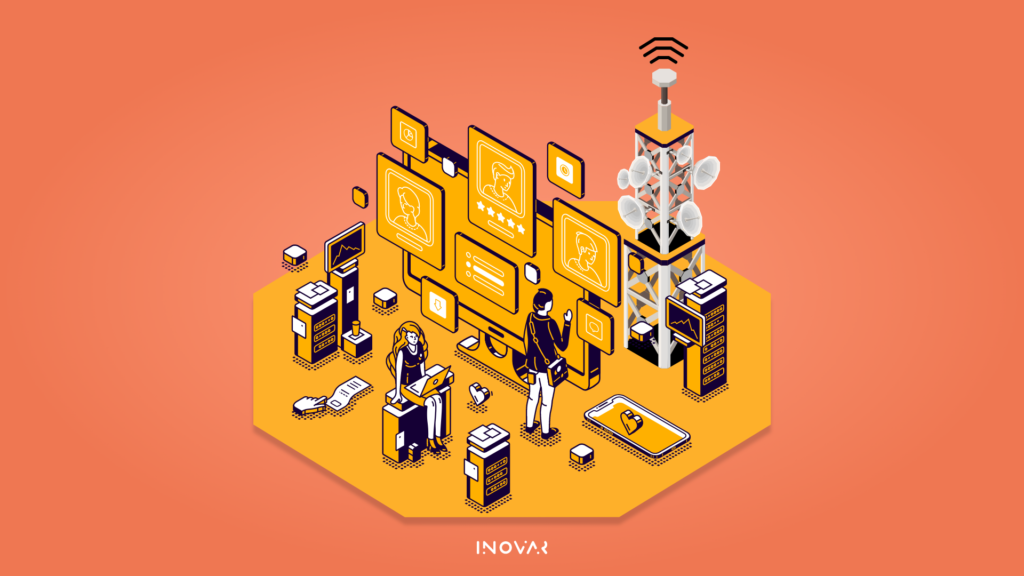
By implementing SharePoint Online telecom organizations can move a lot of their vital collaboration tools to the cloud, enabling peer networks to share problems and concerns, access a single content from a different point, and add value while on the move. With the offline access feature, all data automatically gets synchronized between SharePoint Online and local computers whenever a network connection is available.
SharePoint Online offers a real-time co-authoring feature to enable the stakeholders to collaborate in real-time.
Our proficiency in providing SharePoint solution
Our US telecom client was facing collaboration and communication issues due to an improper and interrupted operation. According to Shivsankar Barik, VP Delivery of Inovar Consulting, the main challenge was that our client’s organization had an issue in collaborating with peers and reaching out to the right SPOCs to find important information.
Our target was to provide them with an automated technical solution to ensure effortless operations and uninterrupted communication. We cut down their time to market and improved their operational efficiency with a 40% improvement in site/signal compliance achieved with the help of big data analytics and helped them migrate from SharePoint on-premise to SharePoint Online. The entire automated environment enriches the visualization and monitoring power in a network. It also provides real-time alerts to avoid any sudden failure.

“What started as workflow automation solution, resulted in huge cost savings optimizing end to end process”- Apratim Ghosh (CEO, Inovar Consulting).
We have come a long way since then having managed their existing SharePoint Sites, built net new sites for different teams. Data security and access control are other vital concerns of our clients. We deploy a hybrid cloud solution applying next-gen technology for controlling access with better data security.
Automated telecom infrastructure with a customer-centered, data-driven culture can drive profit, increase productivity and significantly reduce costs. If you are also looking for an automated technology solution to manage your telecom networking and communication systems feel free to reach out to us.
The pandemic has changed how people around the world live, work, and engage with each other. In late 2019 when covid-19 struck the world, affecting millions of people all over the planet — the healthcare industry was hit the most. The pressing need for resources, information, cost optimization, and supply chain inefficiencies in the sector calls for a major technology overhaul. Therefore, embracing new-age digital technologies is key for healthcare providers in addressing the immediate concerns and driving long-term goals.
Automation makes a revolutionary process change in most of the industries, that has the same or even more potential for the healthcare sector. Introduction of Business Process automation can streamline the healthcare system for simplicity, increase service quality, and manage pen and paper-based manual tasks, saving time and cost without the slightest glitch.
Challenges in Healthcare
Application Disparity: Modern healthcare is a complex environment where many disparate applications work. The complexities also grow with the business. With mergers and acquisitions, modern technologies are adopted to meet new challenges. In this situation managing all technology becomes quite difficult for the healthcare IT departments and business users.
For example, in most healthcare sectors, patient data transfer is still carried out manually in the form of files and documents from one department to another. As the volumes of data are generally high, compiling them in one single process is a tedious and lengthy process. Not to forget, since they are done manually, there is always scope for multiple human errors and miscalculations. The greater the rate of error, the more the cost will be for rectification.
Lack of efficiency in patient service is another challenge that can be a barrier to your organization’s growth and reputation. In most scenarios, customer care executives are busy with paper works and other files and documents compilation that they lack prompt and timely delivery of services to the customers.
I hope you can relate to the problems I discussed above. So now I am going to share how automation becomes an integral part to solve some of healthcare challenges.
The business automation software works on all programs whether, new applications, legacy programs, cloud-based solutions, or on-prem.
BPA makes human-oriented processes much smoother with greater results like increased speed, productivity, and efficiency. Suppose for a patient, scheduling an appointment with a doctor usually happens online in a matter of minutes, but what happens behind the scenes is a bit more complicated. Healthcare institutions have to collect personal information, diagnosis, insurance details, and confirm the doctor’s availability. If the right information cannot be accessed during the registration process, or if the doctor is not available, it is up to the staff to inform the patient beforehand.

Implementing automation can resolve some of the bottlenecks related to scheduling patient appointments. Bots can automate patient data collection and processing, so patients can be optimally scheduled according to diagnosis, location, doctor availability, and other criteria. By simplifying appointment scheduling, healthcare institutions can focus their efforts on providing exceptional service and other tasks that cannot be automated. Automation tools also enable customer care executives to take the assistance of such tools with automated call and email options.
Inovar proposed Automation Solutions with better ROI
Something similar also happened with one of our US healthcare clients. They were also facing customer support challenges during the pandemic. They were primarily using a pen and paper-based system for information collection and symptom analysis. After the outbreak of the virus, a lot of patients started asking for support in their chatbot regarding diagnosis, vaccination, and other medical support.
With a lot of restrictions, it becomes necessary to give patients the capability to run the assessments on their own from the comfort of their homes. Remote work capability also became especially important, and they needed an infrastructure through which they can achieve that.

To manage the entire scenario, they required VPN, which was not designed for such large-scale use resulting in low bandwidth and frequent outages. Additionally, a lot of the content and manual workflows required the physical presence of the employees on the hospital premises that was quite impossible at that moment.
In this critical situation, the first hurdle to cross was to get them to a cloud-based solution to ride care facilities across all their nation-level operations and provide the best health support to patients. This would make remote work possible for the hospital staff in case they were showing symptoms and had to quarantine at home.
In this situation, Inovar helped a leading US healthcare organization to automate their Covid-19 Helpdesk and Registration process from a pen and paper-based manual system to a cloud-based automated solution.
SharePoint Online became the choice of the platform along with Power Platform as their primary productivity technologies allowed them to create a technology framework with a built-in rapid growth mechanism and assist hospital staff to manage the entire remote work process.
With the implementation of the initial solution, the healthcare organization was also facing challenges to roll out the solution in all other locations of the US that becomes much fair with SharePoint and the power platform.

A simple but practical experience gained a high adoption rate within the healthcare organization. The organization’s IT team also considered it as the best rollout experience with almost a zero-touch provisioning and deployment strategy. Ultimately, with all these solutions 90% of their remote and quarantined caregivers were able to serve the patients over remote calls and Online consultation.
The digitization of call centers was a major bonus as it consisted of Automated Diagnosis for Covid, automatic decision-making capabilities, and other similar tools that ensured self-help services that were non-existent before. This resulted in a reduction of 70% in phone calls.
Businesses transitioning from manual processes to comprehensive workload automation tend to go through several phases on their automation journey. If you are also facing the same difficulties within your organization, then Inovar is the best partner to collaborate with and make your automation journey smoother. Feel free to reach out to us we would love to collaborate!
With every progressive step of technological advancements, the priorities of CIOs are also changing. Process transformation and automation have gained much of leaders’ attention in recent times. Automation, the use of machines to perform work, most commonly refers to using the use of computer technologies to perform the tasks humans would otherwise do as part of their jobs. The use of computer-based process automation is widespread, with organizations deploying a broad range of software automation tools to help them reach the automation goals they set as part of their larger digital transformation objectives.

According to the December 2020 Global Intelligent Automation (intelligence AI) Study from Deloitte, *73% of organizations worldwide use automation technologies. That’s a significant increase from the *58% of organizations using such technologies in 2019. Gartner reported that organizations’ interest in a process of transformation is accelerating, demand for robotic process automation (RPA) software witnessing the growth of **19.5% from 2020.
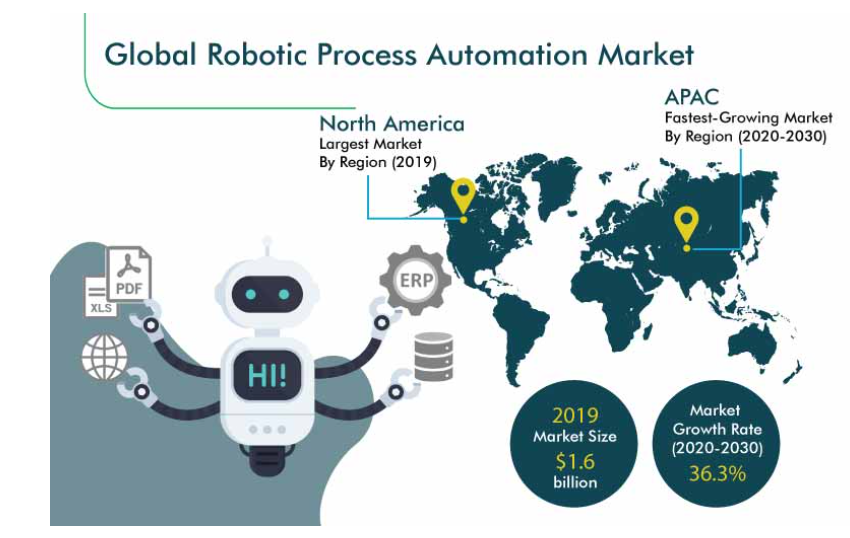
But, RPA is not the only process automation technology that companies are leveraging to drive goals, efficiency, and digital transformation. The diversified business sector embraces certain other automation options such as business process automation (BPA) and digital process automation (DPA). Each of the three technologies offers benefits, and each has distinctions that separate it from the others.
What is robotic process automation (RPA)?
RPA technology mimics the way humans interact with software via a UI to perform high-volume, repetitive tasks. The technology creates software programs, or bots, that can log in to applications, enter data, calculate, and complete tasks, and copy data between applications or workflows as required. But RPA doesn’t inherently have intelligence or decision-making capabilities. Hence, the work best suited to RPA is rules-based. These are discrete tasks done the same way over and over, with no deviations that require human decision-making. According to Gartner, RPA represents a major portion of the automation market. Experts believe that the primary benefits of RPA are increased efficiency, lower costs, and reduced errors. RPA bots can perform tasks faster and with consistent accuracy and reliability. They can work round-the-clock without taking breaks.
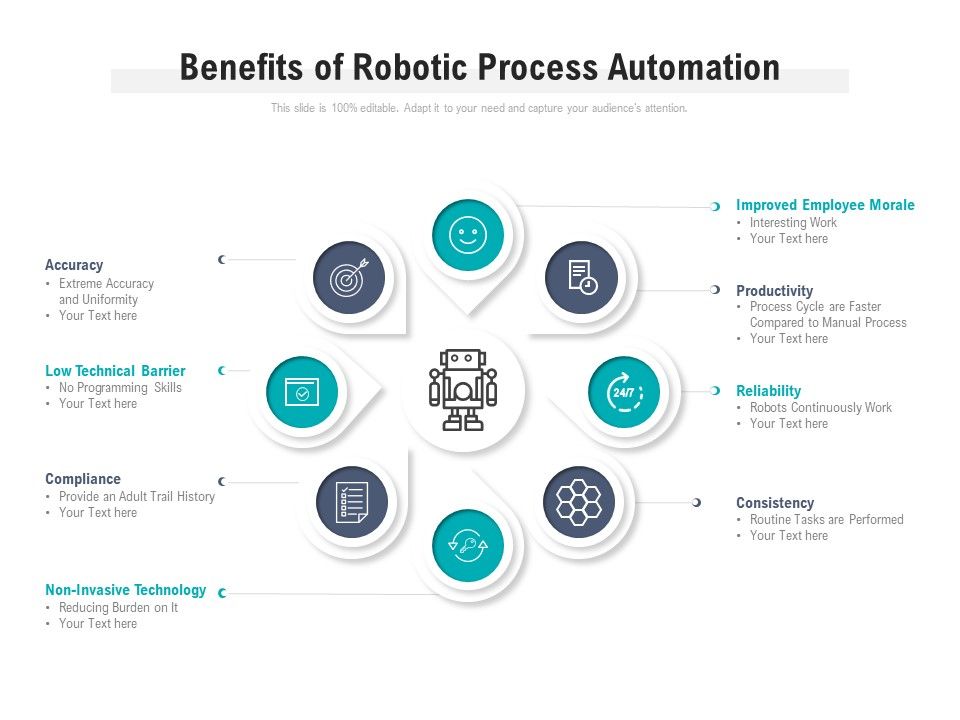
Another reason for RPA’s growing popularity in the enterprise is its relative ease of use. RPA works with an organization’s existing infrastructure and applications. Also, because many vendors offer low-code/no-code RPA platforms that require little to no programming experience, business users can harness RPA, creating their own bots with minimal help from their IT departments. As such, business users are driving much of the RPA adoption.
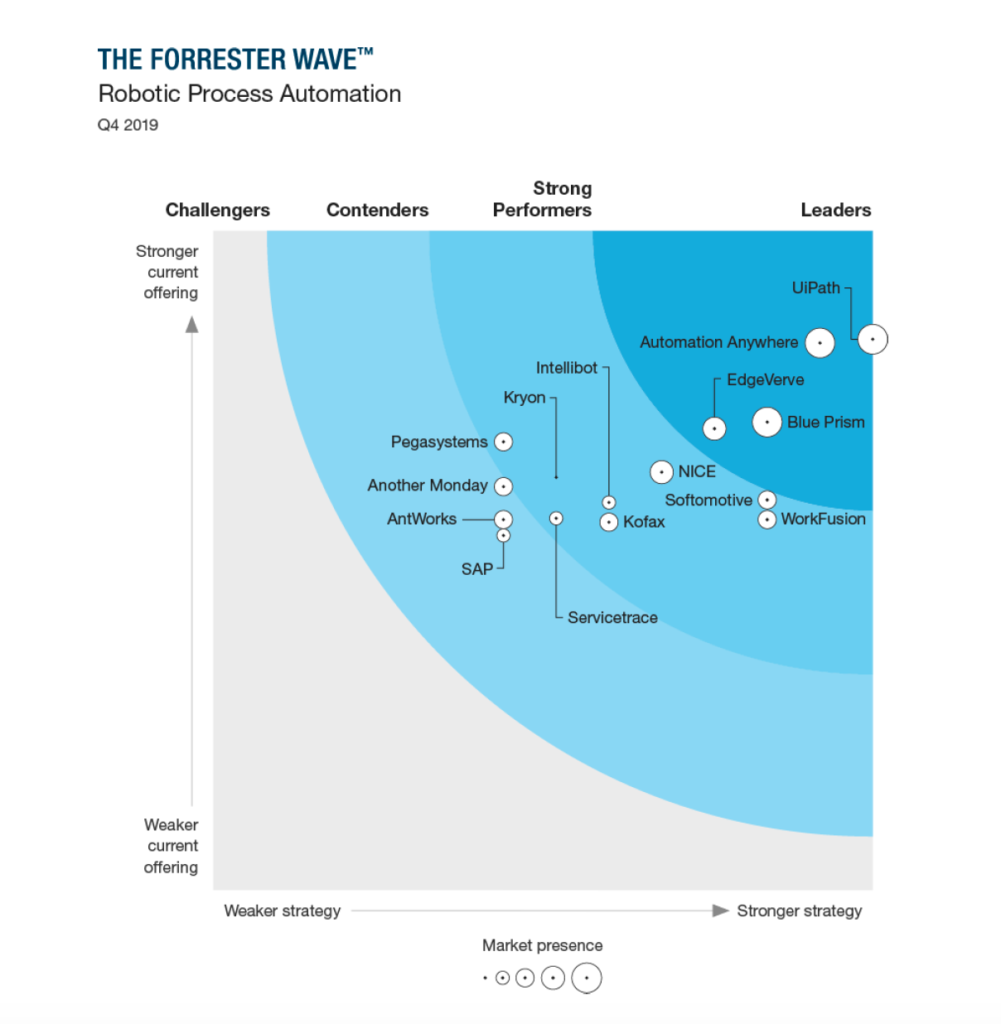
What is digital process automation (DPA)?
DPA is a software technology used to automate a process and optimize the workflow within an automated process. A big focus of DPA is to improve employee and customer experiences by taking friction out of the workflow. The software is used to create efficiencies and enhance UX experience in various areas of the enterprise, from IT service requests to onboarding new employees and client intake.

Organizations use DPA to automate a process from its beginning to its end. Typically, DPA is used for the longer and more complex processes than the tasks that can be effectively handled by RPA. These processes can contain multitudes of decisions that, if using RPA, would create bots that are too long and too difficult to maintain.
As per a ***Forrester schema, DPA is divided into two types: DPA-deep, and DPA-wide, which is closely related to RPA:
- DPA-deep is automation that transforms and improves a business process and, because of the complexity, requires skilled technologists to implement and focus on continuous
- business users and can be managed by the business and delivered using low-code platforms and Agile methods.
What is business process automation (BPA)?
BPA automates workflows within an organization; as one step in the business process is completed, the BPA software then automatically triggers the next step. BPA software is used to automate complex, multistep business processes that are usually unique to an organization and are part of the organization’s core business functions.

Size of the business process automation system (BPA) market worldwide from 2016 to 2021
BPA’s holistic approach stems from the technology’s capability to work across the multiple enterprise applications and systems required to complete a typical business process. Organizations often first analyze and improve a business process with a BPA approach before automating it, which is different from the mimic-as-is tactic typically used in RPA.

Reworked, optimized processes using BPA remove human hands from the workflow; with human workers no longer involved in the automated process, they’re not introducing individual workarounds or unauthorized changes to the workflow. Consequently, enterprises use BPA in their digital transformation efforts for the accuracy, efficiency, and reliability it brings to each automated process.
Experts Opinion on – RPA Vs BPA Vs DPA
Some experts use BPA as an umbrella term for a wide range of process automation technologies but there are varied opinions on that concern as well.
According to Gina Schaefer, intelligent automation lead at Deloitte Consulting LLP said- “DPA, BPA, and RPA — are practically interchangeable.”
She further added – “Digital, business process and robotic process automation are essentially the same. When applied appropriately, these refer to comprehensive end-to-end process automation. Specifically, these terms refer to the use of scripted automation software to mimic human actions in the execution of rules-based ‘swivel chair’ type tasks, typically where an individual accesses and processes data from multiple applications.”

InovarTech is ready to improve your automation experience. With our smart forms and streamlined workflows, you will be ready to tackle process technologies and know-how to adapt them to your institution. Reach out to us today to get started. You can take comfort in the fact that we know process automation and how to implement them effectively. Let us deliver high-volume processes to your doorstep.
Resources:
**– https://www.information-age.com/rpa-revenue-reach-nearly-2-billion-2021-gartner-123491711/
Jeanne W. Ross (MIT Sloan’s Center for Information Systems Research) says-
“Clearly, the thing that’s transforming is not the technology — the technology is transforming you.”
Staying relevant has never been difficult – difficult was, to be adapted to the rapid pace of innovation, drive by the number and variety of new technologies, and most importantly, step forward with the growing economic pressures after the global pandemic. From the “big bang” to the “e-commerce boom” we have surely come a long way. But now digital transformation is probably the real buzzword for e-commerce businesses and global industry leaders.
We could start this article with a definition of digital transformation and why it’s essential for running an e-commerce business in 2021, but that would be boring (as most people aware of digital transformation and its benefits) – so we won’t. Instead, we decide to focus on the two principal aspects—
- What are the driving forces behind the digital transformation in ecommerce?
- How will digital transformation drive the future of e-commerce?
Before we dive too deep into this topic, I think it’s valid that first answer the question:
How does COVID-19 affect e-commerce businesses?
The standardized lockdown rules across the globe and the growing hesitation among consumers to go outside and shop for essential goods have tilted the nation towards e-commerce. Consumers have switched from shops, supermarkets, and shopping malls to online portals for the purchase of products, ranging from basic commodities to branded goods. Since the norm of social distancing has been initiated scope of online purchases and online businesses skyrocket. Many people have embraced the concept of online retail, and the surge in FTUs (First Time Users) on e-commerce sites is visible.
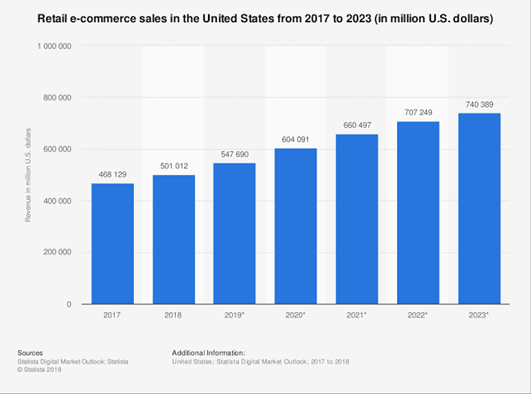
(Source: Statista.com)
As per the statista report, the market opportunities for online commerce in world are expected to touch $740 billion by 2023 from $468 billion in 2017. Based on the data available, the growth in the countries like Indian, Philippines, Malaysia are going to beat other established markets like US, Mexico, China by 2034.
On the downside of things, lack of productivity during the nationwide lockdown resulted in the loss of jobs, pay cuts, and finances. Shutting down shops and family-based businesses has made many people sway towards online retail to meet their financial requirements.
In that situation, digital transformation isn’t jargon extracted from a pretentious keynote speech, it becomes an essential part of staying in business. Now, B2B and B2C companies compete against their online rivals to take a slice of the e-commerce pie, and companies who don’t keep up quickly go bust. The above facts work as a catalyst behind the adoption of digital transformation strategies in e-commerce.
The driving force behind the digital transformation
1. Shoppers are looking for new products online
According to salesforce, 87% of shoppers look for product information and helpful reviews online — even if they plan to make their final purchases in a brick-and-mortar store. Consumers always expect to find up-to-date information and brand contact information quickly and easily.

2. Consumer expectations continue to rise
Modern consumers are now expecting to personalize experience across a range of channels. Have you heard of Omnichannel Marketing? People are enjoying apps and hope their shopping basket to travel from device to device. Hence, you need to cater to your customer base to grow your bottom line.
3. A robust online presence of brand to show value
The majority of growing brands now choose direct-to-consumer, rather than wholesale marketing strategies. The main point behind this: cut out the middleman and make more profit, and consumers get to communicate directly with brand manufacturers. Strong online presence and robust branding are the primary weapons to create a roadmap for success in that type of marketplace.
Now, you have enough reasons to implement digital transformations on the e-commerce platform. But reasons aren’t enough, you also need to know how to implement digital initiatives in your every business touchpoint. Below we describe in detail the digital trends, which will make your work much easier.
How digital transformation will shape the future trends of e-commerce.
Digital transformation does not have an endpoint, so you won’t have a chance to sit back, dust off your hands, and say, “Right— that’s it.”
Keeping up a digital vision and mindset is the most vital aspect of your organization’s digital transformation. Hence, you should keep a track of your customer expectations to modify your tactics and meet the need of your customer demographic. Instead of worrying many entrepreneurs try to approach change management with a sense of adventure and opportunity so that they can invest in new business processes and reap significant rewards. Let’s look at the principal ways of digital transformation change in e-commerce in the coming future.
1. Technology in the frontline
Only the will to achieve digital transformation is not enough. E-commerce sectors need to acquire and successfully deploy the right technology if their efforts are not to be in vain. To achieve success, e-commerce industry should improvise their IT infrastructure and software — management and maintenance skills must also be in place. Skill shortage in the IT part means rather than looking inward, B2B companies are increasingly having to explore possibilities outside the enterprise for technology provision. This puts a greater emphasis on cloud-based infrastructure and solutions, managed services, and automation.
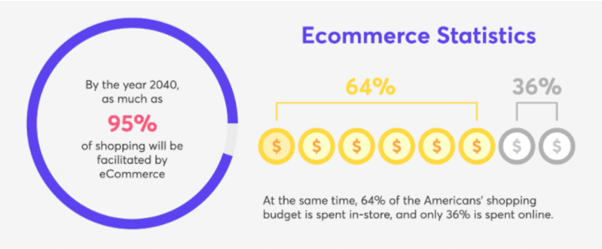
(Source: centerity.com)
Automation is not necessarily direct AI-related technology — is a necessary step in the development and delivery of digital transformation for e-commerce at this stage. Some widely using automation processes are natural language processing (NLP), and cognitive automation, robotic process automation in conjunction with AI, and others. Here I want to highlight the top five ways to leverage automation for e-commerce business—
- Using the modern email marketing strategy, a brand can easily build automated workflows that schedule messages based on user activity or important dates. For example, the “Abandoned Cart Saver” engine works on a 100 percent automated basis.
- An online business can also automate the collection of customer feedback without any first-hand involvement.
- Inventory management is one of the tedious aspects of e-commerce that can simplify with automated accounting software- such as keeping track of purchase orders, updating the number of products in stock, or calculating the real-time valuation of your inventory.
- Automated invoicing is another essential aspect.
- Now, a business can also develop a chatbot with the help of AI without writing a single line of code.
2. Significance of big data and analytics in enhancing personalization
Big data is one of the substantial parts of e-commerce digital transformation. Giant retailers use this technology to provide consumers with highly personalize shopping experiences.
You know how they make this magic?
Online giants are using machine learning to modify site algorithms based on previous consumer activity because they recognize that familiarity boosts the bottom-line. May in the future, it will be easier for people to opt-out of personalization. But, for now, companies continue to push personalization on the Internet of Things (IoT) devices, like thermostats, doorbells, and artificial intelligence (AI) tech (think Amazon Alexa or Siri). With all these approaches, data is becoming a larger and larger component – and therefore a challenge – for many organizations.
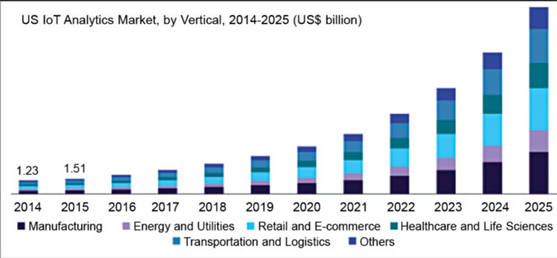
(source: iot.electronicsforu.com)
Data analytics initiatives require a clear understanding of the objectives they’re put in place to achieve and the resources available to implement them. Stakeholder and user requirements may influence the selection of software and services. Hence, the business should choose their technology or solution partners with these considerations in mind.
3. Cloud to cater to the changing market demand
There is myriad of advantages e-commerce is drawing from cloud computing today. Most importantly, cloud in e-commerce enables the business to look big virtually and operate extensively. To make it clear, I want to highlight four crucial aspects:
- Cloud computing qualifies e-commerce applications to cater to the changing demand and scenarios of the market. It allows to upscale or downscale the online services based on demands, traffic, and seasonal spikes.
- For an e-commerce business, speed plays an important role to keep customers glued, and cloud computing provides you with greater bandwidth, computational power, and storage.
- With the cloud-native technology, strategy e-commerce can cut down the costs of developing and maintaining IT infrastructure.
- At the time of catastrophic data losses or security threats, redundancy is significant to overcome the disaster and resume business streamline. A cloud-based platform with built-in redundancy can save a business from data loss.
4. Headless and API-driven strategy continued innovation
We have a ton of favorite sites, but do we have any idea how those sites work? We hope online at free time, fulfill our midnight cravings, and go back to work. Behind the scenes – our order preferences travel faster than the speed of sound through a headless commerce system and file neatly into its database.
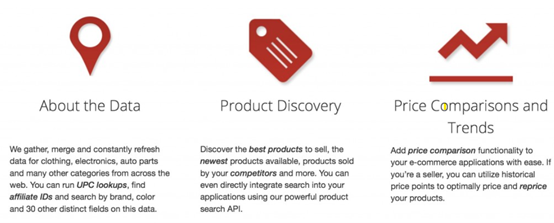
(Source: ecommerceinsiders.com)
In a nutshell, headless commerce decouples a company’s e-commerce platform from its frontend. When uncoupled, any data entered a website’s backend travel seamlessly to a range of frontends via application programming interfaces (APIs) — for example, progressive web apps (PWAs) and content management systems (CMSs). In order to leverage these techniques, companies add content to a compatible backend and couple on APIs – or customized frontend (like reaction button). Is it sounds too complex?
Check out few additional reasons behind use headless commerce:
Flexibility: Headless commerce is SEO friendly, and it is flexible and agile across a range of devices.
Personalization and customization: Businesses can control the consumer experience from start to finish by using a headless commerce tech stack, streaming data from one central database to a collection of APIs.
5. Content and digital web presence
Content and the creation of brand narratives can boost the processes of building a stronger digital presence while fostering brand recognition.
Content and storytelling can help reach customers and create more brand loyalty, as well as establish companies as thought leaders and experts in their field. Through a clear content program, a brand can drive product offerings with a briefing on necessary aspects and influence purchasing decisions of customers. This is an area where manufacturers and distributors need to incorporate a broader Customer Insight/experience strategy to maximize outcomes and increase revenue.
Digital web presence is often how customers experience the brand for the first time. This is also a route for improving customer experience and increase website conversion rate. According to a statistic, most consumers leave a website if it takes more than 3 seconds to load. Digital UX and UI is playing an important role to help users navigate through the website, find their requirements, and develop a trustworthy connection with the brand. Many organizations are still developing and improving the functionality of their websites and eCommerce platforms, both on the user and internal sides. Websites can drive additional growth and revenue – but they can also play a role in capturing more data, sourcing out leads, and boosting customer engagement.
6. Digital transformation at an organization level
Digital transformation is moving beyond eCommerce and marketing, to embrace the organization. It’s looking at what leadership is involved in decision making, undergoing internal process changes, and even creating new job responsibilities and titles.
New recruitment practices for digital transformation are seeking out software engineers, user experience experts, and data scientists to acquire the needed skill sets and embed the right innovation mindset across the board.
Apart from that increasing mobile shopping experience, the wide spreading of alternative payment methods, direct to consumer strategies are accelerating the digital revolution in the e-commerce industry. From understanding how buyers make decisions (and who those decision-makers are) to opportunities for more personalized content and messaging in all funnels, digital transformation technologies and data management help enable more effective e-commerce business techniques. Now, this is the time to align all business digital touchpoints with business goals, and digital strategy consulting companies are here to help you navigate through all these digital strategies. For more information and consultation feel free to reach to digital consulting service company Inovar Consulting.
Digital transformation is the integration of digital technology into all areas of a business, fundamentally changing how one operates and delivers value to customers. With all the service options a customer has nowadays, the relationship a service-provider has with its customers has never been more critical. Businesses must be agile and flexible to meet their evolving demands, and the onus is on these businesses to support those needs and streamline efficiency.
Additionally, a digital transformation strategy helps employees being more engaged. With updated systems, applications, and solutions, it’s easier to communicate with customers, partners, and co-workers, and it leads to better collaboration as well, helping them succeed in driving important business initiatives.

There are many ways that a company can gain benefit by instituting a digital transformation plan, some of which are short-term wins, while others become more obvious down the line. Here are the 6 critical factors that lead to success in Digital Transformation.
- Setting a strategy that covers what, why, and how and defines specific business outcomes
- Winning leadership commitment from CEO through middle management
- Finding the most capable people to drive the program
- Developing an agile governance mindset that is flexible and adaptable.
- Establishing clear metrics for processes and outcomes
- Building modular tech and data platforms driven by business needs

The key to addressing all six factors is planning, preparation, and execution of digital transformation strategy. Once the plan is fixed, then one can determine what it is that one wants to gain from upgrading the digital foothold. Digital Leaders have accomplished an earnings growth 1.8 times* higher than companies that resist Digital Transformation. Organizations that get these 6 elements right have an 80%* chance of success.

Out of the six factors mentioned, two of them are the most critical:
Agility is the key – Organizations need to ensure that all operations adopt an agile approach to work. This means learning continuously, acting as one team, being outcome-oriented, and being committed to action. While making this shift, having an agile mindset is of utmost importance. This requires an authentic belief in the behavioural changes required, as well as supporting tools such as playbooks, processes, and support to work in a cross-functional, mission-oriented way.
Soft skills are as important as tech skills – Another key factor is spending enough time to get the right people in place and then supporting those people. Leaders need to find the best people with the highest potential to lead a successful transformation. A few things to assess when finding a transformation team are:
- Have you taken extra care to fill pivotal roles such as program manager?
- Are there enough digitally literate people to drive new thinking?
- Have you sourced team members tactically from business units so that they can become champions in critical areas?
- Do you have a detailed assessment of the skills required and gaps to be filled?

In addition to tracking progress toward goals, company leaders should track the momentum of the project. Digital Transformation leaders should ask these questions to measure momentum:
- How strong is the business pull for digital solutions versus the program push?
- How do the most talented people in the company feel about joining the program, wary or excited?
- Are executives diverting funding to other initiatives or defending the transformation project?
- Are people trying to lower expectations about the work or talking up the advancements?
These “threshold behaviours” are a good indicator of whether the work is headed in the right direction or stalled out. Success is measured by the percentage of targets met and value created, the percentage of goals met on time, success relative to other transformations, and success relative to management’s aspirations for sustainable change.
InovarTech eliminates the complexity of end-to-end integration with a modern cloud integration platform that connects B2B Data flows, applications, and data across the entire ecosystem and drives complex digital transformation efforts.
References:
*6 ways to win at Digital Transformation from TechRepublic
Over the last few years, the telecom industry has witnessed a heavy decline in revenue in core areas like voice and text messaging along with severe competition from Over-The-Top Service providers. Today the telecom industry is poised to undergo Digital Transformation due to the swift emergence of IoT and 5G. By making the services customer-centric, improving efficiency, and adding high-value margins, they can move away from traditional services. Just as cloud computing has changed the world of data, it is now changing the way the telecom industry operates. Many organizations have started adopting cloud-hosted solutions to streamline data delivery and utilize a single supplier for voice & data services.
Telecom is a people-intensive industry, with a seasoned workforce that includes teams in offices, on trucks, and in retail storefronts. Being forced to work from home due to the ongoing pandemic has impacted their productivity and increased security and infrastructure risks for customers. Technology has transformed almost every sector across the globe and the telecommunications industry is no exception to it.
Here are a few solutions that we feel can cause a dramatic change in the telecom industry:
- 5G Network – The Network of Today and Tomorrow
There are billions of internet users around the globe and most of them prefer smartphones as their primary internet access point. With smartphones now helping users manage important tasks in their lives, consumers look for high capacity networks that promise faster access to applications and richer services. Telecom giants, with the help of various technologists, have already started rolling out their 5G to a multitude of industries such as healthcare, automobile, and education. This expansion of telecom into all sectors by automating processes for online customers is what can bring back the telecom industry to its true potential.

- Managing Big Data
IoT enables telecom companies to acquire an enormous amount of data with the help of various sensors in mobile devices and apps. With the help of tech giants, companies can ensure that their network can move this data efficiently and continue to support new technologies. The data collected helps to generate crucial business insights and understand customer usage patterns which can ultimately be used to improve customer service and evaluate new products to optimize the network.
- Cloud adoption to unlock revenue stream
Most telecom providers rely on a large computing infrastructure to deliver a diverse set of applications, manage data, and bill services. Migrating to the cloud reduces internal computing resource needs as well as internal costs while increasing revenue streams. The pay-per-use service model helps telecoms to introduce new services, reduce the cost of the service, and work more effectively as per the market demands. By adopting cloud technology, telecom industries can switch important business functions to the cloud and benefit from its efficiency.

- Cybersecurity
The telecom sector is one of the most vulnerable sectors when it comes to cybersecurity. With telecom companies having a large customer base, there are abundant opportunities for malicious attacks to gain unauthorized access to their data. The consequences of infrastructure under attack could potentially affect a whole country and its government agencies. Thus, by adopting a holistic approach, telecom providers are able to detect threats, take up prevention measures, and support resilience when attacked.
- Robotic Process Automation (RPA)
The telecom industry has one of the highest adoption rates for RPA technology. It offers high levels of scalability and agility as it takes over the repetitive and rule-based tasks or processes. This enables companies with the right tools to easily manage back-office work such as maintaining data integrity and security, employee salaries, marketing, and advertising, thus giving employees time to work on crucial tasks and develop deeper customer relationships.

- ChatBots to manage customer base
As the telecom industry is now slowly based heavily on technological advances, many are already using AI technology such as virtual assistants, chatbots, and tools to improve customer experience and satisfaction. These solutions provide an unmatched ability to process and analyze an enormous amount of big data that provides valuable insights to improve the quality of service and increase revenue.
The telecommunications industry has been relaying messages between individuals and businesses for over 2 centuries – even during crises. Stress tested for resilience during the past 200 years, this industry is sure to evolve and emerge even more prepared for the decades ahead. There are a lot of new trends in this growing world of the telecom industry, but they all rely on the fundamentals of technology as a niche. By being able to provide reliable technology with a focus on the clients, one may be able to expand exponentially in the future.
In 2020, low code speaks about a movement within technology because, in future, 50%*** of all new business applications will be created with this visual coding tool. If you are not familiar with the term low-code platform for app development, then get ready because you are about to start hearing it everywhere. Global businesses are now creating add-on pressure on developers in demand for multichannel applications to gain competitive advantage. In that scenario, low-code development platforms are accelerating the delivery of business applications with high productivity and offering better customer experience.
The worldwide low-code development platform market generated $10.3 billion revenue in 2019 and is expected to witness a CARG of 31.1% during the forecast period of 2020-2030**. Most of the tech companies consider low-code application platforms because it requires minimal coding and enables faster delivery with the help of pre-packages templates, graphic design techniques, and drag-n-drop tools. Below, three key factors work as driving force in this platform:
- Increasing demand for business digitization
- Less dependency on the information technology
- Stringent government norms on technology adoption

According to the Salesforce.com survey report, over 76%* of IT professionals were profoundly interested in low-code app development, which may scale up to 81% in 2021. More than half of the business is now happening using the low-code programming because developers consider this process viable for the development of the mission-critical application and high-level programming language.
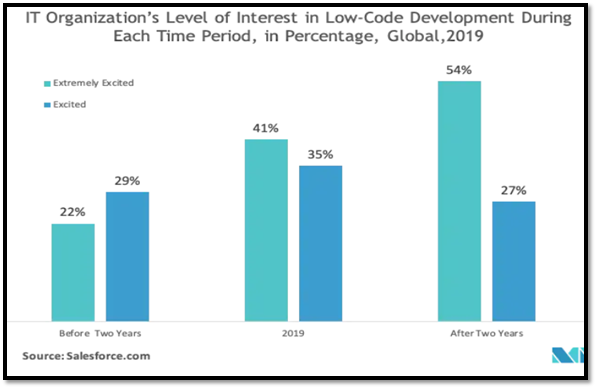
The rapid digital transformation has created a significant impact on major industries like Retail, BFSI, FMGC, E-Commerce, Media, and others. Undergoing process of digitization is a multi-faced journey, and not a single tool or approach will make the transformation to reality. But the bespoke platform can play a central role in the mixed method of digital transformation by reducing the load on IT and accelerating development time than traditional development process. This low-code solution empowers users to build solutions to meet their exact requirements that increase organization agility. This rapid transformation can evaluate the company brand position in this competitive market with a better customer experience.

The ongoing outbreak of COVID-19 is working as an additional fuel on the growth of low-coding platforms. This global pandemic pummels the economy, shredding profits and millions of jobs, now organizations are looking for a new platform to change. In that scenario, low-code automation is helping organizations adapt to massive disruption by quickly combining human and digital labor in the same workflow. COVID-19 has resulted in some of the complex problems mentioned below, for which low-code offers an excellent solution.
- Rapid business transformation in Retail and Healthcare
- Immediate need for applications
- A drastic shift in business strategy models
- Technical debt, and unavailability of talents become burden for companies

This pandemic has forced many small retailers and healthcare organizations to adopt or leverage their online marketing just for survival. Education, Pharma, and other small businesses are now depending on low-code solutions for an immediate need for new software applications. Self-reporting apps on disease symptoms, apps for online classes, government apps for the temporary service are now of outrageous demand. AD&D services in the insurance sector, airlines, retail, and healthcare are in the first row of low-code app demand. Moreover, cost of maintenance and update is quite low in this platform that can reduce company technical debt.
As per the Gartner report, Salesforce, Microsoft, Mendix are the topmost service leaders in fastest-growing low-code environment who have configured the cloud-native deployment options to minimize the operational risk and align organizational needs.

At Inovar, we are fully aware of the benefits of the low-code development platform and have aided one of the biggest healthcare centers in the US. We have helped them to migrate from their existing manual process to a low code solution to help patients amid this global pandemic. It was a comprehensive solution which included, dashboards, online forms where patients can ask any query or find details regarding doctor consultation quickly.
The old way of doing things might not die out completely, but people may be more reliable on low-code platforms as low-code programmers are going to lead the development environment. In a nutshell, in the era of rapid transformation, maybe companies won’t get much time to follow the lengthy development process or reinvent new wheels that can make apps redundant before they are even released. It will be the best time to believe in empowering IT developers and supporting them in creating a whole new ecosystem of application development.
Hence, do not allow yourself to be on the wrong side of history and empower your business with the right trend of the market.
References
* LOW CODE DEVELOPMENT PLATFORM MARKET – GROWTH, TRENDS, FORECASTS (2020-2025), Mordor intelligence, Retrieved from: https://www.mordorintelligence.com/industry-reports/low-code-development-platform-market
** Low-Code Development Platform Market Research Report: By Offering (Solution, Service), Deployment Type (Cloud, On-Premises), Enterprise (Large Enterprises, SME), Vertical (IT, BFSI, Retail, Healthcare, Government, Manufacturing, Media and Entertainment, Education, Energy and Utilities) – Global Industry Analysis and Growth Forecast to 2030, PRESCIENT& STRATEGIC INTELLIGENCE Retrieved from: https://www.psmarketresearch.com/market-analysis/low-code-development-platform-market
How Low-Code Technology Accelerates Digital Transformation Retrieved from:
https://www.businessprocessincubator.com/content/how-low-code-technology-accelerates-digital-transformation/